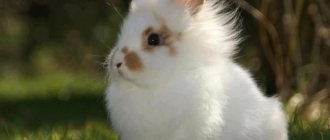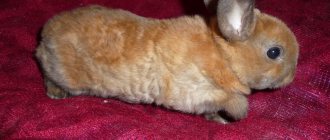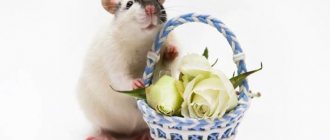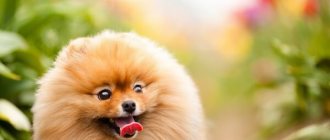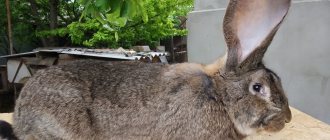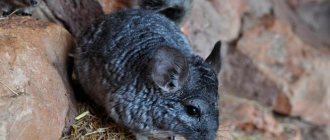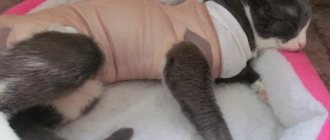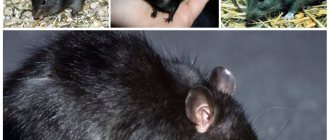How long do decorative rabbits live? How long do decorative rabbits live?
It is best to purchase a furry pet in specialized pet stores. They will tell you in detail not only about the vaccines given, but also about proper care, and will also recommend a specific breed depending on the buyer’s wishes.
Before you get such a pet, you should know how many years a decorative rabbit lives at home. Life expectancy is mainly affected by care and feeding. So if an animal is constantly exposed to stressful situations, it can get sick. Poor nutrition or overeating also causes many health problems, due to which its lifespan is significantly reduced. The average life expectancy is from 5 to 8 years.
How many years a decorative rabbit will live depends on its breed. Folds are cheerful and playful animals. They live on average up to 8 years, slightly longer than rabbits with erect ears. But with proper and careful care, they can live up to 13 years. Dwarfs are easy to train and can be walked outside. The maximum weight of such a rabbit is 1.5 kg. On average, they live up to 5-7 years, but there are also centenarians who have lived up to 15 years.
Factors influencing lifespan:
- genetic inheritance, the healthier previous generations were, the longer the current ones will live;
- infections, parasites and injuries;
- feed;
- conditions of detention and care;
- stress;
- castration.
The tubular bones of these animals are extremely fragile. The rabbit should not be allowed to fall from a great height or be thrown, as this may cause a broken vertebra or hind leg bone. There have been cases when animals injured themselves due to an overly large jump made from an unexpected fright.
Reasons affecting the life expectancy of rabbits
How long a pet will live depends on many factors:
- heredity;
- timely vaccination;
- sterilization;
- nutrition and mobility.
Rabbits on farms are often kept in cramped cages, without movement. This content is intended for rapid weight gain. Keeping kings in a cramped cage for a long time can lead to obesity.
Pets live in completely different conditions. They are fed well, walked, and spend a lot of time with them. This increases life expectancy. But even with good care, pets change their behavior with age; they grow old.
Decorative rabbits size. RABBIT DECORATIVE
Class: mammals. Genus: the classification includes 8 genera. Family: hares. Habitat in nature: decorative rabbits are not found in nature. Their ancestor, the European rabbit, lives on every continent except Antarctica. Currently, more than 60 breeds of decorative rabbits are registered, differing in size, purpose of breeding, constitution, type of coat and fur. Life expectancy: 7-10 years. The size and weight of a decorative rabbit largely depends on the breed. Large decorative rabbits reach the weight of an average well-fed cat - 5 kg. The most common breeds of decorative rabbits: Rex, Squirrel, Butterfly, Fiery Black, Chinchilla, Dutch, Angora, Marder, Siamese, French Ram.
Description Decorative rabbits are small animals with a round body and long ears. Decorative rabbits can be either short-haired or long-haired, with a variety of coat colors. The tail is short and covered with fur. These animals have very strong hind legs, and the hind legs are noticeably longer than the front ones. Rabbits, unlike rodents, have two sets of incisors located parallel to one another.
Character Rabbits are lively, playful, inquisitive, sociable creatures. These animals can show affection and affection. They need attention from their owners and do not like loneliness. During long absences, owners may become bored. Decorative rabbits are very timid and distrustful, afraid of sudden noise, loud sounds and sudden movements. When breeding decorative rabbits, only the appearance was taken into account, the type of character was not taken into account, therefore the character of each pet is bright and individual.
Relationships with other pets Rabbits get along well with guinea pigs, but it is better to keep them separately as rabbits have very strong hind legs and, when pushing off to jump, they can cause very serious injury to the guinea pig. Rabbits can get along with cats if introduced gradually and carefully. Cats are often even afraid of decorative rabbits. Dogs, especially hunting breeds, rats and birds can be dangerous to rabbits.
Attitude towards children Small children who do not know how to be careful when handling animals should not be left alone with pets. Experts recommend having rabbits in families where children are 7-8 years old.
Training Rabbits are not very intelligent, but they are quite clean and can be litter trained. They quickly begin to understand many commands and prohibitions (for example, the ban on chewing wallpaper), but are in no hurry to carry them out. They remember their nickname and respond to it. Most rabbits can be tamed and will sit in your arms, allowing you to stroke and caress them. However, there are breeds of rabbits that do not want to be handled and remain almost wild. Decorative rabbits quickly get used to a special harness and willingly accompany the owner on a walk.
Nutrition The best food for decorative rabbits is grass, high-quality fresh hay and succulent food consisting of greens and vegetables. Lettuce and cabbage leaves, carrot and cucumber mugs, a sprig of parsley or dill are good options. You can offer a sprig of clover or dandelion. All greens must be washed. Greens and vegetables should be introduced gradually and little by little, monitoring the animal’s digestion. Cabbage leaves should be given starting from 3 to 4 months, due to flatulence, which often occurs in babies. Apple slices are suitable as a treat. Veterinary experts believe that food consisting of crackers, grains, flakes, corn and dried fruits is not optimal for decorative rabbits, since rabbits are originally herbivores. Moreover, such food often leads to diseases of the digestive tract. Ready-made food purchased at a pet store should be used only in cases of extreme necessity, for example, on the road, when you do not have the opportunity to make a salad of herbs and vegetables. Recent studies have shown that the cause of jaw abscesses, constipation, diarrhea and dental problems is poor nutrition, in particular the use of cereal mixtures and crackers. Plants that are poisonous to rabbits are: buttercup, nightshade, anemone, dog parsley, poisonous hemlock, poisonous hemlock, foxglove, wild radish, celandine, spurge, wrestler, larkspur, oleander, ovengrass, wisteria, belladonna (demadonna), goat's rue, geranium, crow's grass eye, lily of the valley, datura, black henbane, autumn colchicum, spotted arnica, poppy, etc. Water should be fresh and filtered.
How to recognize an animal's old age
If you start your livestock business by purchasing young animals, then there will be no problems with determining age. Puberty of females occurs at the age of 3-4 months. Males become mature at the age of 5-6 months. It is from this period that the animals are separated into separate cages so that the males do not fight. Animals selected for fattening are castrated and kept in one pen or spacious cage. Male breeders can now be allowed to approach females.
The active phase lasts up to 3 years - this is the best period for mating and producing healthy offspring.
The older the animal, the less active it is. Rabbits sleep more and become calmer. It is at this age that it is best to buy an adult pet to keep at home.
At the age of five, animals already begin to experience age-related health problems. They need to change their diet and give additional medications.
You can recognize the real age of a rabbit by its appearance:
- sagging skin appears in the abdominal area;
- the sparkle in the eyes is lost and there is no interest in the environment;
- hair loss begins and it becomes sparse;
- calluses appear on jump ropes;
- the animal feels temperature changes particularly sharply;
- individuals begin to lose weight or become too obese.
If you have no experience in accurately determining the age of a rabbit, then you need to contact a veterinarian.
Decorative rabbits care. Domestic decorative rabbits
Decorative rabbits have become very popular recently. These cute little animals are bought as gifts for children or simply as pet companions. Caring for and maintaining animals is simple. Their food is cheaper than meat for cats and dogs. After all, rabbits are herbivores, you can prepare hay for them yourself, and vegetables and grain cost pennies.
Decorative rabbits
Preparing to buy a rabbit
Before you decide to buy a pet, read everything about decorative rabbits. It is important to find out how to care for them, what to feed them, and what diseases they have. Then you need to decide whether you want to get a large or a dwarf animal. After all, both the size of the cage and the space that you should allocate for your pet depend on this.
You can keep your rabbit in a cage or enclosure. The requirements for the cells in which they will live are as follows:
- It is advisable to choose a size 4 times larger than the size of the rabbit, the normal area is not less than 60 × 80 cm
- The tray in the cage should only be made of plastic so that the baby does not damage his paws and claws; before moving the rabbit in, it should be washed
- The bedding is made from sawdust or shavings; the rabbit will simply eat the straw
- You need to prepare a special tray for the toilet, but it should be placed in the cage after the tenant has mastered it
- A special manger for hay, feeders for grain and wet mash, a drinking bowl or bowl for water are placed in the cage
- It is also necessary to equip a small house where the animal can hide
- If desired, you can put a wheel or other toy in the cage
- A rabbit can grind its claws down on its own if it has the ability to dig holes in deep litter.
You can make an enclosure for a rabbit yourself. You need to build a fence from plywood or mesh, lay a wicker rug on the floor, covering it with sawdust on top. Just like in a cage, you need to put a manger for hay, food bowls and a drinking bowl in the enclosure. Be sure to come up with a small house for the rabbit and prepare a toilet tray for it.
The cage or enclosure should be placed in a shaded place, away from drafts or heating devices. It is advisable for the rabbit to live in a bedroom where people rarely enter during the day. If this is not possible, place the animal in the quietest corner of the house. During the day he loves silence, noise frightens him greatly, and the animal gets stressed. Due to unrest, the life expectancy of decorative rabbits decreases.
Buying a rabbit
So, everything is ready to receive a new tenant in the house. Now you can start choosing and purchasing. It is best to purchase an animal from a trusted pet store or contact a nursery for decorative rabbits. This way you will have a better chance of purchasing a healthy animal of the desired breed.
How to choose the right decorative rabbit? First you need to know that these animals come in regular and dwarf sizes. Mini animals will not take up much space in the apartment, they do not need a huge cage. The weight of babies is about 1 kg, and the weight of large decorative species is 3-4 kg. Plus, dwarf breeds look very cute. Large rabbits are also decorative, but they need a lot of space, food, an aviary or cage will take up almost half the room.
Now you need to decide on the length of the coat. According to this principle, rabbits are divided into:
- Shorthair
- Normal-haired
- Long-haired.
The short to medium coat is very easy to care for and does not require brushing. But long-haired ones require regular treatments, otherwise their fur will become tangled and look unsightly. Rabbits also differ in the shape of their ears. Fold-eared rams are very popular now; they look cute, but also require special care. Animals can have very different colors - white, black, white with black, red, gray, spotted, blue animals are very beautiful.
Choice of breed and price
The oldest decorative breed is considered to be the white Polish decorative rabbit Garmelin, who bred it is unknown. The most popular and beautiful varieties:
- Hermelinas
- Dutch color minor
- Lop-eared dwarf ram
- Angora
- Vienna blue dwarfs
- Lionheads
- Foxes
- Japanese
- Dwarf Rex
How much does a decorative rabbit cost? This question often worries novice owners. The cost of decorative rabbits depends on the breed, its purity and where the animals were purchased. The price for dwarf pets starts from 1000 rubles per individual. You can find it cheaper, but the quality and health of such animals are questionable. In nurseries and stores the average cost is 1500-2500 rubles. Elite breeds cost 3500-4000 rubles. If the baby rabbit is from show parents, they ask for 5000-7000 rubles.
Before buying, be sure to read how to distinguish breeds, see what the baby rabbits look like when they grow up, carefully study the description and characteristics, colors, etc. It is best to buy an adult rabbit, the ideal age is six months. Its maintenance, feeding and care are simpler.
Features of care and maintenance
How to care for decorative rabbits? What conditions of detention does he need? To make your pet feel normal, you should adhere to several rules:
- Decorative rabbits tolerate cold well, but do not like heat. The optimal temperature for them is 18-20 degrees. If it is very hot in the summer, you should place a damp towel on the cage or a bottle of ice inside it. You can wipe your rabbit's ears with cool water, since heat exchange occurs through the veins of these organs.
- Rabbits are nocturnal animals; they sleep during the day and become active in the evening, closer to 6 p.m. Therefore, you should not disturb them in the morning and at lunchtime; it is advisable to remove unnecessary sounds and fuss from the house at this time, or place the cage in a far corner.
- Fluffy animals are very clean; they go to the toilet in one place. You need to track where the baby rabbit shits and put a tray there. Wash the cage 2-3 times a week to prevent an unpleasant odor.
- In order for decorative rabbits to feel good in an apartment, they need to be walked daily. To do this, the baby is released from the cage for 1-2 hours, having first removed everything that can be eaten from the floor, as well as dangerous objects, so that the rabbit does not injure itself. Walking outside is also acceptable, but only in dry, warm weather and with a harness.
How to choose a pet
Knowing what a rabbit's life depends on, you can take care in advance to ensure that the acquired pet lives as long a life as possible, making the most of nature's potential. And first you need to choose the right animal. So, it’s better to buy:
- A baby rabbit between four and six months old. Young children are still too vulnerable to stress and infectious diseases, so it is better for them to stay with their mother until their immune system is strengthened. Older animals are also not a good option for purchasing, since their character has already been influenced by the conditions of their detention (as a rule, breeders keep animals intended for sale in cages and do not surround them with the care that a pet can count on in the home of loving owners) .
- Proven breeds, being wary of newfangled varieties based on the combination of a large number of mutations not found in nature (any change of this kind may be associated with other congenital pathologies that will manifest themselves in the future).
- An animal in a nursery with a good reputation, preferably with a pedigree, which you should definitely look into to ensure there are no inbreedings (common relatives within at least four to five generations).
- An absolutely healthy and active baby who eats with appetite, makes contact easily, shows curiosity about surrounding objects, has shiny coat of good quality, clear and unclouded eyes.
You should not buy rabbits that are excessively timid or sit apathetically in the corner of the cage. Reasons to refuse the purchase are also:
- bald spots in the coat;
- watery or red eyes;
- dirty fur around the anus;
- wet chest.
Important! It has long been noted that albino rabbits live shorter than their counterparts. How the substance that affects the color of the fur is connected with the animal’s age is not completely clear, but this relationship objectively exists.
Dutch decorative rabbit. Dutch rabbit
Dutch "ram"
Over the past 10-15 years, miniature breeds of rabbits have steadily settled in our apartments as full-fledged pets, but until relatively recently they were considered, to a greater extent, expensive exotics, often compared with other popular representatives of the exotic fauna.
One of the popular breeds of dwarf rabbits available for breeding at home is the “Dutch” breed.
The Dutch rabbit breed, despite its European name, was bred in England in the 19th century, but only in 1970 the breed was able to enter the territory of the former USSR, where it almost immediately gained popularity among lovers of exotic animals.
The Dutch breed has a rather calm, peaceful character; the species composition of the “miniature” branch includes 3 species: the Dutch decorative rabbit, the Dutch dwarf rabbit and the Dutch lop-eared (ram) rabbit.
Dwarf and decorative breeds differ in appearance only in size.
The lop-eared ram, in addition to its similarity with the dwarf ram, is distinguished by its fallen
(by day 14) on the sides with ears.
Fur can have several color options: white, gray, squirrel, sable, tortoiseshell and others.
The weight of the decorative breed varies from 2 to 4 kg with an average size of 25 to 40 cm; dwarf and fold-eared breeds weigh up to 1.5 kg with an average size of 15-20 cm.
The lifespan of the Dutch breed is approximately 5 to 7 years.
Dutch dwarf
Speaking about the maintenance of decorative and dwarf breeds, it is still worth remembering that in fact these are the most ordinary rabbits with appropriate requirements and certain care.
In terms of adaptive properties, the “Dutch” are quite hardy and can adapt to various conditions of detention, but, as breeding practice shows, it is still not worth neglecting the conditions of detention, since this, to one degree or another, can affect the animal.
Cell
As mentioned above, decorative and dwarf rabbits are smaller copies of their ordinary counterparts, who need exactly the same conditions for a comfortable existence as their wild relatives.
The main rules for maintenance are space and cleanliness.
For the Dutch breed, a cage of 70 cm or more is suitable. Focus on 3-4 sizes of the animal, because when the rabbit grows up, it will need space to lie down or stand up to its full height.
The bottom should be lined with sawdust and hay, approximately 3-5 cm deep.
Make sure that the cage is not in a direct draft so that the rabbit will not freeze from the cold or overheat in direct sunlight. Room temperature will be enough for the rabbit.
Experienced owners are advised to purchase a heavier feeder, preferably made of ceramic, since rabbits are prone to turning over. As an option, you can consider a hanging type feeder.
The drinking bowl should always be filled with fresh water.
Used litter should be changed 2 times a week or more often.
Feeding the Dutch rabbit
Dutch decorative rabbit
Dwarf and decorative rabbits have a specific digestive system. This must be taken into account when creating a menu.
The stomach is single chambered and very small.
Due to the high speed of digestion, the number of meals can reach up to 30 times only in old individuals, while young animals are able to eat 2 times more.
Hay must be included in the main diet - this is the main food.
At home, you can dilute the diet with millet, vegetables (boiled potatoes, carrots, cabbage, beets), fresh grass (dandelion, plantain, nettle, clover) or purchase ready-made food for the appropriate age at a pet store.
In an unusual way, dwarf rabbits replenish their vitamin reserves: they happily consume some parts of their own waste as food.
It is also worth remembering to maintain the mineral composition: pressed chalk is suitable for these purposes.
Adults must lay down branches to eat the bark.
Important things to know about Dutch rabbits:
Even dwarf rabbits should be given the opportunity to run around in an open space and should be allowed out of the cage periodically.
As practice shows, walking a rabbit in an apartment in 99% of cases results in immediate damage to property - from scratched wallpaper to chewed wires.
Therefore, it is recommended to organize a walk in the fresh air and in an enclosure, and it is better if the rabbit leaves the cage on its own to avoid stress.
- Dwarf rabbits are able to become litter box trained and go to one place.
- If the rabbit behaves badly and tries to bite, then the right option would be to lightly press it to the floor - this way you will make it clear that you are stronger and the “master” of the house.
- Periodically cut your nails using a nail clipper, carefully so as not to accidentally cut the blood vessels.
How to extend the life of a pet
Preventive measures to prevent the premature death of a pet and prolong its life include:
- Regular vaccination. It is imperative to vaccinate decorative rabbits against the two most dangerous diseases of a viral nature - myxomatosis and necrotizing hepatitis (viral hemorrhagic disease). If contact with other animals is possible, vaccination against rabies is also advisable. The frequency of scheduled vaccinations is once every six months, with the first complex vaccination given at one and a half months of age, followed by revaccination three months later. The rabies vaccination calendar looks different: the first vaccination is given to a baby rabbit at the age of two to two and a half months, subsequent ones are carried out every year.
- Complete and balanced nutrition. In addition to regular dry food, the rabbit should always have fresh, dry and fragrant hay in its cage (it is better to buy it at a pet store, since self-dried herbs can contain pathogenic microflora and industrial waste residues, which are fatal to an ornamental pet). To provide calcium, the rabbit must be given chalk, and in order for the animal’s teeth to grind down properly - solid food: fruit tree sticks, special “spikelets” and other similar “chewy treats”.
We should also not forget about vitamins: a deficiency of retinol, tocopherol, cobalamin and vitamin D is especially critical for rabbits. There are a number of seemingly safe and familiar foods that are strictly contraindicated or extremely undesirable for rabbits (for example, cabbage, sunflower seeds , nuts, tomato tops, dairy, sweets, baked goods, meat, etc.). This list should be carefully studied and taken into account. - Motor activity. If there is an opportunity to please your pet with walks in the fresh air, it should not be neglected, but only when we are talking about a country house, park, forest or meadow. There is nothing for a pet to do in a smoky city yard, especially since such experiments are fraught with various tragic accidents - from an attack by a neighbor’s dog to death under the wheels of a passing car. However, it is imperative to let the animal out of its cage every day so that the pet can “stretch its bones” and realize the need for communication for at least a couple of hours. To prevent your pet from getting bored the rest of the time, it is useful to place various toys, labyrinths and other entertainment in the cage, which should be changed periodically.
- Temperature regime. To make the animal feel comfortable, the cage should not be placed in a draft, in the sun or near heating devices. [
The optimal temperature that is suitable for keeping rabbits is in the range between 16 and 18 °C, and the maximum permissible deviation from the specified parameters in either direction is 6 °C. Too cold air provokes colds in rabbits, and too dry and warm air affects their genitourinary system. - Minimizing bathing. Rabbit fur does not tolerate wetness well, but in order to protect its valuable coat from the proliferation of various parasites, it is useful for your pet to sometimes take sand baths. Special material for these purposes can be purchased at a zoological store.
- Cleanliness in the cage. A sanitary regime is the key to the health of a fur-bearing animal. Contact with wet bedding not only has a detrimental effect on the condition of the fur and increases the development of infectious diseases, but also causes irritation of the respiratory tract due to the ingress of ammonia and carbon dioxide vapors into them.
- Reduce stressors. Decorative pets do not like sharp sounds, noise and light effects, as well as other surprises.
- Avoiding contact with other animals that can frighten, injure the animal, or infect it with any disease.
- Minimize the risk of injury. It is household injuries that are the most common cause of premature death of decorative rabbits. For this reason, it is better not to pick up animals unless absolutely necessary (children should be prohibited from doing this at all), not to be allowed to walk unattended on high surfaces from where the animal can fall, and to carefully look at your feet when the pet is released from the cage and you can walk on it. step on, etc. You should, in addition, know that the long ears of a rabbit are not at all intended for grabbing the animal by them and lifting them up. You should also not hold the rabbit by its paws or lower it upside down.
- Sterilization. If a pet is not used in breeding programs, it is better to sterilize it, since unfulfilled sexual instincts are the cause of the development of many serious pathologies that can lead to premature death.
- Love from the owner. This rule applies to all pets, and decorative rabbits are no exception. Actually, it is the attentive and responsible attitude of the owner that makes it possible to detect in time that something is wrong with the animal, and to respond to the problem in time (adjust the conditions of detention or diet, show the pet to the veterinarian, or simply play with a bored baby).
In terms of life expectancy, decorative rabbits differ little from their wild ancestors, as well as from breeds that are bred for agricultural purposes. But if it is important for a farmer that his herd remains healthy and gains weight well only for a certain period, he always wants to extend the life of pets as much as possible. On average, rabbits live about seven years, but if you create good conditions for your pet, it is quite possible to extend this parameter by one and a half, or even twice!
Life expectancy of different breeds
Wild rabbits inhabiting northern Africa, southern Europe, and Australia live approximately 10-12 years. However, this age is more likely to be typical for the inhabitants of the Australian continent, where animals in nature have no potential enemies. In other regions in the wild, on average, rabbits live up to approximately 3-5 years.
This is due to the presence of predators and various diseases. Therefore, the lifespan of rabbits often depends not on the aging of the body, but on other factors: climate anomalies, lack of treatment during illnesses, parasites, infections, hunting seasons.
Animals living in private homes, where they are raised for slaughter, live an average of 4-5 years. Usually, individuals of the meat breed are not kept for more than this period. But if rabbits are not slaughtered, they can live up to 8 years, and after castration up to 12.
Decorative breeds that are purchased for apartment living can live from 4 to 10 years.
The table shows the life expectancy of different breeds.
| Breed name | Health | What age do they live to? |
| New Zealand | Strong immunity and resistance to climate change. | 5-10 |
| Silver | They do not require careful care and have good health. | 7-10 |
| Burgundian | Does not suffer from gastrointestinal diseases. | 9-10 |
| American | Unpretentious in care. Not susceptible to disease. | 12 |
| Belgian | They are resistant to diseases, but birth defects are common in rabbits. | 5 |
| Strokachi | They are able to withstand severe frosts and have strong immunity. | 7 |
| Ober | Strong immunity, good tolerance to low temperatures. | 5 |
| Dutch | Requires good care. | 3-10 |
| Lop-eared ram, rex | Unpretentious, rarely get injured. | 7-8 |
| Hermelinas | Good selection, strong immunity. | To 10 |
| Colored dwarf | Delicate and often subject to injury. | 4-5 |
Signs of old age
The first signs of the aging process are:
- decreased activity (the animal lies for a long time, rests);
- the appearance of the coat changes (it becomes dull, sheds);
- the shine of the eyes decreases (they become cloudy);
- decreased appetite;
- sagging skin in the lower abdomen.
Aging should not be confused with signs of illness. To be sure, a veterinarian is called to your home or the animal is taken to a veterinary hospital for examination.
Where is the best place to buy a dwarf rabbit?
The worst option for purchasing a domestic dwarf rabbit is at markets or through private advertisements. There is a high probability of fraud here - when an ordinary Eastern European rabbit is sold under the brand name of a purebred animal.
Before purchasing an animal, you should know about the main characteristics that an ideal pet must meet:
- the baby rabbit is at least 1.5 months old;
- mandatory anthelmintic treatment;
- vaccination against VHD (viral hemorrhagic disease) and myxomatosis;
- Preferably a pedigree.
It is better to buy a dwarf rabbit in a specialized club or in a reputable nursery
Even before purchasing an animal, you need to decide on the gender of the future pet and the desired breed. After this, you can start looking for your pet. You can buy a dwarf rabbit:
- in a pet store;
- by hand, according to the owner’s announcement;
- in a specialized nursery or from a club breeder.
Please know: purebred dwarf rabbits with impeccable pedigree and excellent health can participate in exhibitions and competitions and be used for breeding.
Receiving medals at dwarf rabbit exhibitions makes it possible to breed animals
Purchasing a miniature rabbit in a store has one main advantage - you can almost always buy the animal here, without waiting in line and at a low price. However, a “store-bought” dwarf rabbit may well turn out to be the wrong breed; sellers cannot always give practical advice on keeping animals. In addition, due to not the best conditions for keeping mini-rabbits and their overcrowding, it is possible to acquire a sick rodent or a pregnant female.
Dwarf rabbits in pet stores may have serious hereditary problems or diseases
Purchasing a pet based on an advertisement from former owners of a dwarf rabbit is a common option for acquiring a pet. Due to various circumstances, people are forced to part with their pets, so you can buy a purebred rabbit along with its cage and toys at a reasonable price. You just need to remember that the animal may have an advanced age or a chronic illness, which the previous owner will not tell you about when selling.
Prices for cages for rabbits
Rabbit cage
A purebred rabbit from healthy breeders can be purchased at a nursery or from an experienced breeder
The most convenient option is to buy a dwarf rabbit at a nursery or club. Here you are guaranteed to purchase an animal of the desired breed, with all documents and evidence of health. A breeder or nursery specialist will advise on all issues related to keeping a rodent at home; at first, he will be able to supervise the pet and give professional advice to the new owner.
How to choose a nursery to buy a dwarf rabbit?
To purchase a healthy dwarf rabbit that can delight owners with its fluffy charm for many years, you need to choose the right nursery. In order not to make a mistake with the purchase, it is advisable to pay attention to the following characteristics of the rabbit breeding club:
- experience in the chosen field - in most cases, nurseries specialize in breeding certain breeds of miniature rodents;
A good nursery breeds 1-2 breeds of dwarf rabbits
- the presence of professional rabbit breeders on staff with specialized education and relevant certificates;
- planned breeding work aimed at improving the breed;
- The equipment of the nursery allows to avoid overcrowding of animals, single cage housing is provided;
- regular veterinary examinations, anthelmintic and vaccination measures;
- providing advisory activities and veterinary care for purchased rabbits;
- obligatory provision of pedigree and veterinary passport of the baby rabbit.
Important: when choosing a nursery, you should proceed from the documentary evidence of professional level available to the breeders, your own observations and reviews of previous clients.
A dwarf rabbit from a nursery must be examined by a veterinarian, and all vaccinations are indicated in the animal’s passport
Determining the gender of the baby rabbit
Dwarf rabbits of the same breed at the age of 1-2 months are completely indistinguishable from each other. If an animal is purchased from an experienced breeder or nursery, then the sex of the animal is indicated in the documents - it is determined by professional veterinarians and rabbit breeders. When purchasing a dwarf rabbit in a store or market, the new owner of the rodent is faced with the problem of determining the gender of the pet.
Determining the sex of a tiny rabbit is possible by careful examination of the genitals
If the animal has reached three months of age, then males can be identified by their descended testicles - they look like small seals next to the genitals. In younger rabbits, sex is determined by their genitals.
- To determine the sex of the animal, you should perform simple manipulations:
- move the tail to the side and sit the rabbit on its hind legs with its belly up;
- lifting the rodent by the withers with one hand, carefully squeeze the genital organ with two fingers of the other hand;
- in a female, when pressed, you can see a pinkish triangle, in a male, a pointed penis.
In a rabbit girl, the genitals look like a narrow slit, originating directly from the anus. The male has a round throat located at a distance of 3.5-4 cm from the anus.
Rabbit genitals
How to determine the gender of a rabbit?
In addition to studying the genitals, the sex of a rabbit can be determined in several other ways. From our article you will learn about the primary and secondary sexual characteristics of rabbits, the differences in the behavior of females and males, and why you need to know what gender your pet is.
What you need to buy before bringing a rabbit into your home
Before you bring a decorative rabbit into your home, you need to arrange a place for it to live and provide the future pet with the necessary equipment.
Among the required items you need to purchase:
- A cage with a plastic tray that is at least 4 times the size of the baby rabbit.
- Drinker (preferably automatic).
- Feeder (preferably a heavy ceramic one so that the animal cannot turn it over).
- A tray for excrement.
- Wood filler.
- Sennik.
- Toys that can be chewed and chewed.
- Special stone with minerals.
- Claw clipper.
- A brush for combing wool.
- A carrying container for safe transportation of the animal if necessary.
What affects the lifespan of ornamental varieties
To extend the life of your family pet, you need to pay attention to the following nuances:
- genetic predisposition;
- good nutrition, proper feeding regimen and balanced diet choices;
- maintaining an optimal microclimate and hygiene;
- constant monitoring of the animal’s health;
- lifestyle (it is worth walking your pet, playing active and active games with it);
- castration (rabbits castrated in childhood grow faster).
With proper care, domestic rabbit varieties live for approximately 5 years. Video How long do rabbits live at home? How to extend the life of a rabbit? Domestic rabbits and rabbit castration
Proper nutrition for a rabbit is the key to its longevity
In addition to hereditary and biological factors, it is necessary to take into account the domesticated living conditions of ornamental animals. Anyone who is going to have such an animal at home should first of all remember: rabbits have an extremely delicate digestive system. Its specificity lies in the fact that the single-chamber stomach of a rabbit has too high a degree of digestion. In this regard, animals can eat up to 20-30 times a day, and baby rabbits even more.
Figure 4. The temperature in the room where the rabbit lives should not exceed 20 degrees.
In this regard, it is necessary to carefully monitor the diet of rabbits from a very early age, so as not to spoil their gastrointestinal tract and shorten their life expectancy. Improper nutrition, as a rule, can lead to obesity in decorative breeds of rabbits, liver, heart or stomach diseases. Dwarf rabbits prefer the following foods and plants:
- hay or fresh grass;
- oats, barley and legumes;
- turnips, carrots, zucchini, cauliflower;
- pumpkin, beets, white cabbage;
- apples, bananas;
- dill, rhubarb, nettle;
- dandelion, burdock, plantain, clover, etc.
When choosing grass as food for a rabbit, it is better to give preference to juicy, fresh meadow grasses, plants and flowers, excluding lilies of the valley and flowers belonging to the nightshade family, as they can be poisonous to the animal. When adding raw or boiled vegetables and fruits to the diet of rabbits, it is necessary to control the level of freshness, crumble them into small pieces so that it is convenient for the dwarf animal to consume them. Cereals should be thoroughly soaked and can be boiled. Leftover food after the rabbit has eaten must be removed from the cage, preventing it from rotting (Fig. 3). Young branches of trees or shrubs from which pets can strip the bark are required to maintain healthy teeth and good digestion. Birch, apple, rowan, linden or raspberry branches are ideal for these purposes.
